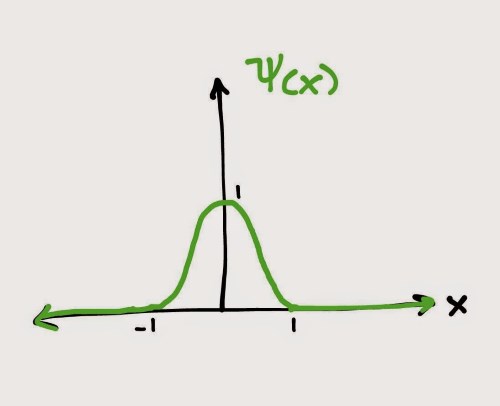Dalszy ciąg poprzednie notki "Na bakier z logiką"
Pod tekstem angielskim przekład polski.
Thuan, Max Born and Schrödinger
Thuan writes:
The German physicist Max Born showed that this probability is equal to the square of the amplitude of the wave function given by the Austrian physicist Erwin Schrödinger.
This is another clumsy and misleading sentence. Max Born did not “show” the above, not to mention that the term “probability” should be replaced by “probability density”. Max Born, in his often quoted paper, “proposed”, and even proposed it wrongly; he omitted “the square”, and only in a footnote, added later, did he suggest that it should be the square of the amplitude, and not the amplitude itself – as he erroneously stated in the text of his paper.
A Suggestion, A Proposal, is Not a Fact!
Once again Thuan takes someone’s proposal and treats it as if it was God Himself who said that, and everybody is supposed to accept it – otherwise Hell is beckoning with open arms!
Thuan continues:
The chance of finding the electron is highest at the crests of the wave function and lowest at the troughs. But even at the crests, there is never complete certainty that the electron will be found there. The chances may be 80 percent or 92 percent, but never 100 percent.
Completely misleading! The distribution of chances depends on the wave function, and these come in all kinds of shapes.
Probably, because of his lack of experience with quantum theory, Thuan assumes a bell-shaped distribution. But then, again, the chance of finding the electron exactly at the crest is always zero. On the other hand the probability of finding the electron “in the vicinity of the crest” depends on how large this vicinity is assumed to be. Depending on that size, the probability can be “almost zero” or “almost one”. If, instead of a bell-shaped Gaussian wave function, we take a wave function that is also “bell-shaped”, but strictly localized (non-Gaussian) in a bounded region of space, then the probability of finding the electron in this region will be strictly 100% (at the moment when the wave is so localized) – contrary to what Thuan tells us.
Are these just unfortunate expressions, or is Thuan actually thinking in such a muddled and misleading way? (I am asking myself.)
Thuan, Max Born i Schrödinger
Pisze Thuan
Niemiecki fizyk Max Born pokazał, że to prawdopodobieństwo jest równe kwadratowi amplitudy funkcji falowej podanej przez fizyka austriackiego Erwina Schrodingera.
Stwierdzenie to jest bardzo niezgrabne i mylące. Max Born nie „pokazał” powyższego, nie mówiąc już o tym, że słowo „prawdopodobieństwo” winno być zastąpione przez „gęstość prawdopodobieństwa”. Max Born w swoim często cytowanym artykule nie „pokazał” a „zaproponował”, i to zaproponował błędnie; pominął mianowicie „kwadrat” i jedynie w przypisie, dodanym później, zasugerował, że powinien być raczej kwadrat amplitudy a nie po prostu amplituda, jak to błędnie napisał w samym tekście pracy.
Sugestia czy propozycja to nie to samo co fakt!
Powtórnie Thuan traktuje to co ktoś zaproponował tak jakby objawił to sam Bóg i wszyscy muszą to zaakceptować, inaczej ogranie ich piekło!
Pisze dalej Thuan:
Szansa znalezienia elektronu jest największa na grzbietach funkcji falowej a najmniejsza w dolinach. Ale nawet na grzbietach nigdy nie ma całkowitej pewności znalezienia tam elektronu. Szansa może wynosić 80 procent albo 92 procent ale nigdy 100%.
Powyższe jest całkowicie mylące. Rozkład szans zależy od funkcji falowej a te mogą mieć najrozmaitsze kszatałty.
Prawdopodobnie z braku doświadczenia z teorią kwantów Thuan zakłada, że funkcja falowa ma kształt dzwonowaty. Ale nawet wtedy szansa znalezienia elektronu dokładnie na szczycie dzwonu jest równa zeru. Z drugiej strony prawdopodobieństwo znalezienia elektronu „w okolicy grzbietu” zależy od tego jak wielką okolicę weźmiemy. Zależnie od wielkości szansa ta może być „prawie zerem” lub „prawie pewnością”. Jeżeli zaś miast funkcji gaussowskiej weźmiemy funkcję także dzwonowatą, ale ściśle zlokalizowaną (nie gaussowską) w ograniczonym obszarze, wtedy prawdopodobieństwo znalezienia elektronu w tym obszarze (nośniku funkcji) będzie wynosiło dokładnie 100% - wbrew temu co Thuan nam wmawia.

Czy są to jedynie niefortunne wyrażenia, czy też Tuan w istocie myśli w taki mętny i mylący sposób? (Sam sobie to pytanie zadaję)
Dalej będzie: Thuan’s Religion of Science and Quantum Theory

